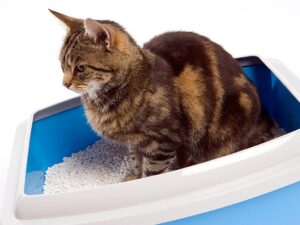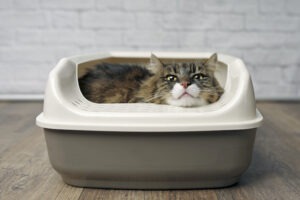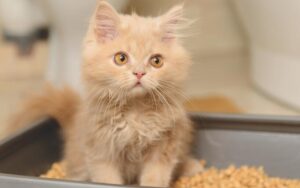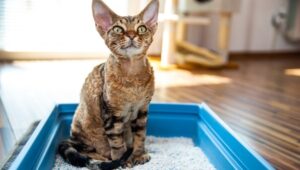As a cat owner, you should understand everything surrounding your cat’s toilet behavior and litter box-related issues. This will help you quickly address health issues and litter box associated problems that may affect your cat’s everyday life.
Generally, most cat owners don’t really know much about their cats, but if you need a healthy cat life, you should have our discussion at your fingertips.

Table of Contents
For How Long Can My Cat Go Without a Litter Box?
Generally, a cat can go without a litter box for up to 24 hours after which your cat may be sick. If our cat hasn’t pee at this period, issues may develop which may cause severe health conditions therefore, you will need to consult your vet.
Consequently, this 24 hour period doesn’t mean that your cat should only use a litter box once a day but we have considered some circumstances such as when traveling as some cats might take a day without a litter box.

The Reasons Why Cat Refuses to Pee in the Litter Box and How to Deal with It
If you have a cat in your home, you will realize that they are so selective since they always respond differently to changes you make on their litter box or medical problems. Therefore, you need to act immediately to cease their avoidance from becoming chronic. So, what causes them to avoid peeing in a litter box? Also, we will give you the solution for each.

1. Medical issue
Health issues may cause your cat to pee outside the litter box. However, there are different types of health problems that need to be conversant with. So don’t worry, we will discuss this for you, and I am confident that you will single out the problem associated with your cat. These medical conditions are;
- Urinary tract infection – if you realize that your cat frequently urinates or spends most of the time licking their genitals hence may be a sign that they have a UTI associated with the use of a litter box. As a result, your cat will probably act strange, therefore avoiding the litter box.
- Feline interstitial cystitis – this condition affects the bladder of your cat. Your cat will appear straining while doing its business. Due to the increased urgency to urinate and the pain involved, your cat may do its business outside the litter box. Also, you may note blood in their urine.
- Bladder stones – if you find your cat crying when doing its business, it is evident that she’s experiencing pain. That may give you an indication that your cat has a blockage.
With this, you have no other option than to visit the veterinary hospital. Don’t wait until the situation gets worse.

2. Dirty litter box
Cats are always sensitive to odor since they have four times the human odor sensitive cells. With a dirty box, the cat won’t avoid using the litter box instantly but instead; you will see a change in the peeing habit as you will find your cat turning her nose up at the litter box, indicating that the litter box is unclean. And eventually, your cat will refuse to use it.
How can you tackle this?If you usually clean your box once a day, you need to scoop out the soiled litter twice a day. However, regardless of how irritating the odor is, avoid using harsh cleaners such as bleaching agents. So, change the litter and use warm water to scrub the box especially if you are using clay litter.

3. Placement and litter box related issues
The litter box’s position has an impact such that if your cat doesn’t like where you place it, she may refuse to use it. For instance, putting a litter box in a noisy place, such as next to a dryer or water heater, your cat won’t feel secured and as a result, she will refuse to use it. Consequently, the size and depth of the litter box may also affect the behavior of your cat. For instance, if the litter box’s sides are raised, older cats will probably experience a challenge when stepping in.
How can you handle this challenge?- Please pay attention to where you locate a litter box since your cat needs privacy. Therefore, don’t place it next to noisy components such as the dryer.
- The litter box should be accessible and avoid changing its location regularly.
- Also, consider a litter box that accommodates your cat’s present conditions; for instance, if she is old, go for a low-sides litter box.

4. Stress
As we have said, cats are so sensitive that small changes to your home may make your cats unhappy. If you recently brought other pets to your home, such as dogs or other cats, your cat may feel insecure. As a result, your cat will avoid the litter box since she might sense that it is dangerous to use a litter box while the other animals are out. Other causes of stress may be, moving to a new place and adding family members.
How can you deal with stress?Regardless of the source of stress, ensure that your cat has a quiet place where new animals cannot access the location. If you have multiple conflicting cats, have more litter boxes.

5. Conflicts
If you have multiple cats, disputes may arise over the use of litter boxes. They always have a habit of marking their territorial, and as a result, the dominant cat may leave her feces uncovered to announce her status and presence. As a result, other cats will feel insecure about using the litter box. This can cause stress to some cats who are unable to defend themselves.
How should you go about it?- Provide a litter box for each cat
- Add an extra litter box to a different location
- Place them at a different location.
What is the Cat Hasn’t Used the Litter Box in 24 Hours?

Some cats can go the whole day without using a litter box which can be disastrous to their health. However, cat owners usually get confused when trying to figure out what exactly is going on with their cats.
Therefore, you should ask yourself whether the litter box has a problem or your cat has a health issue. The litter box related issues can be dirty, high sides if your cat is old enough to get into the box, improper placement, noisy environment, or conflicts if you have multiple cats. Similarly, your cat may be suffering from blockage hence will require medical attention.
How to Help Cat Relieve Their Bladder?
Does your cat have a problem with urinary retention? Usually, some cats find it difficult when it comes to emptying their bladder ion their bladder. But this shouldn’t scare you since emptying the cat’s bladder is more complicated than the dogs. When your cat is urinating, its bladder doesn’t stay stable hence challenging while trying to empty it.

The process involves applying the least pressure on the bladder using your hand to force the urine out.
You need to find the bladder where you have to reach your cat’s rib cage, and at the bottom of it, you will feel a small ball-shaped thing.
Once you get hold of it, use your two or three fingers to squeeze it while pressing it downwards. Be cautious not to apply much pressure but you should squeeze it gently and this will help your cat relieve its bladder.
What if My Cat Peeing Too Much?

If your cat is peeing too much then, this could be a result of a health problem. Your cat may be suffering from polyuria which is evident when your cat urinates larger quantities of urine. This comes as a result of the body’s incapability to regulate urine formation. Also, the body releases a large amount of water and body fluids along with urine. What could be causing polyuria is a kidney disease that affects the body’s ability to retrain the fluids hence faster formation of urine.
Consequently, hormonal-based diseases such as diabetes or hyperthyroidism could be the source. With this, the body won’t concentrate the urine properly thus releasing an excessive amount of water causing your cat to pee a lot.
So, how can you handle the situation? Before you make any step, kindly track exactly what is going on and note all your cat’s symptoms and behavioral changes. Visit the vet’s office, where thorough examinations can be done. Engage in consultation with the doctor who can prescribe the proper treatment.
What You Should Know About Cat Bladder and Urination?

Having the necessary information regarding the bladder and urination of your cat is essential since it will help you figure out your cat’s health condition. Therefore, a healthy bladder should expand to fill and release to empty. This is facilitated by the muscles that are responsible for the expansion and contraction of the bladder.
At some point, if your cat has a problem when it comes to emptying its bladder, then you need to use your fingers to act as a muscle to squeeze the urine out gently. Consequently, you need to track the quantity of urine released such that your cat shouldn’t remove too little or too much urine but if she does, you need to consult the vet.
How Often Should Your Cat Urinate in 24 Hours?

Usually, there is no exact hour-frequency when a cat should urinate. However, most cats usually go to the toilet every 8-11 hours therefore, 2-3 times a day should be the case.
But if your cat doesn’t go to the toilet within the time range, this indicates an unhealthy life. It could be as a result of blockage or any other condition. We can’t guarantee you that your cat is healthy if she observes the time range because if she releases too little or too much urine, there might also be a health issue; therefore, be observant.
How Can I Train My Cat to Use a Litter Box in a Proper Way?

Getting your cat to use a litter box isn’t a complicated task but proper use can be a challenge to your cat. But before we go into details, cat owners sometimes stress their cats by yelling at them, mostly when they misuse a litter box. Therefore, there’s a need to train your cat.
- First, teach your cat what to do hence you might need to show her how it is done. So, you will have to carry your cat to the litter box when she’s about to pee.
- Once you are there, scrape some litter aside by using your fingers and once your cat has done its business, scoop a little litter to bury the waste.
- As a result, your cat will eventually understand to do it on its own.
The New Cat Hasn’t Been to the Toilet, when Should I Worry?

This case is quite typical for the new arrival due to the new environment. However, a new cat can even take up to 24 hours without peeing but if your new cat takes more than 48 hours, you should worry. Your new cat might be suffering from health problems, separation anxiety, box-related issues, or stress therefore, you need to observe the behavior. But if your new cat is healthy, then you should try the following;
- Change the location of the litter box. Ensure that the place is free from disturbance and inaccessible by humans or other pets.
- Change the diet and ensure that your new cat drinks enough water.
- Ensure that the litter box is clean
- It can also be due to the litter box design such that if it is a covered one, you should try the uncovered construction.
Conclusion
To conclude, we would say that knowing your cat’s toilet habit is right for her health. Therefore, use the techniques we have discussed, but if you are still unsure of how to go about some issues, consult a qualified expert. Also, keep your litter box in good condition, a good diet for your cat, zero stress, no conflicts, and yelling at your cat can lead to a happy life.
